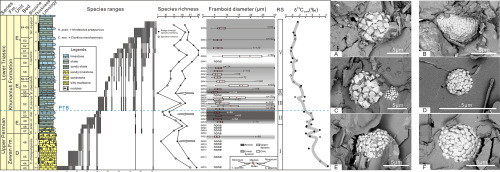当前位置:
X-MOL 学术
›
Glob. Planet. Change
›
论文详情
Our official English website, www.x-mol.net, welcomes your
feedback! (Note: you will need to create a separate account there.)
Two-stage marine anoxia and biotic response during the Permian–Triassic transition in Kashmir, northern India: pyrite framboid evidence
Global and Planetary Change ( IF 4.0 ) Pub Date : 2019-01-01 , DOI: 10.1016/j.gloplacha.2018.10.002 Yuangeng Huang , Zhong-Qiang Chen , Thomas J. Algeo , Laishi Zhao , Aymon Baud , Ghulam M. Bhat , Lei Zhang , Zhen Guo
Global and Planetary Change ( IF 4.0 ) Pub Date : 2019-01-01 , DOI: 10.1016/j.gloplacha.2018.10.002 Yuangeng Huang , Zhong-Qiang Chen , Thomas J. Algeo , Laishi Zhao , Aymon Baud , Ghulam M. Bhat , Lei Zhang , Zhen Guo

|
Abstract Although expanded ocean anoxia has long been believed to be a direct killing mechanism causing mortality of organisms during the Permian-Triassic mass extinction, little has been published on the extent and timing of this anoxia in Gondwana. The Guryul Ravine section in Kashmir, northern India, is a classic Permian–Triassic boundary (PTB) section containing high-quality marine sedimentary and fossil records, and thus provides a unique opportunity to study the redox conditions associated with the biotic crisis in the Gondwana region. Here, high-resolution biotic and redox data were generated from Kashmir to achieve an improved understanding of the nature of environmental stresses associated with the Earth's largest biocatastrophe. Our study, which evaluates pyrite framboid size and morphology, reveals two pronounced stages of oceanic oxygen deficiency, in the assigned latest Permian Hindeodus praeparvus–Clarkina meishanensis Zone and the earliest Triassic Isarcicella staeschei Zone. Updated marine invertebrate fossil records show three sharp species richness declines at Guryul Ravine. The first decline occurred within uppermost Permian storm beds and is interpreted to represent a facies control, in which a storm-agitated environment was inhospitable for benthos. The latter two biotic declines coincided with two marine anoxic events, as documented by pyrite framboid size distributions. The same two anoxic events are also recognized from PTB beds in the adjacent, relatively shallower Barus Spur section in Kashmir, in which newly obtained faunal data help to constrain placement of the PTB. The present study represents a new report of the two-stage pattern of oceanic anoxia during the Permian–Triassic transition. We propose that the two anoxic events at Guryul Ravine correlate precisely with anoxic events in the Meishan GSSP and some sections in South China, suggesting that this event sequence might have been characteristic of the Permian–Triassic transition in some specific geological settings. The close relationship between oxygen depletion and species richness decline suggests that the former were an important contributor to the latter. In addition, we find that many framboids exhibit surface oxidation, reducing their overall size. However, our statistical analysis suggests that the mean oxidation-related reduction in size is
中文翻译:

印度北部克什米尔二叠纪-三叠纪过渡期间的两阶段海洋缺氧和生物响应:黄铁矿小叶证据
摘要 尽管长期以来一直认为扩大的海洋缺氧是二叠纪-三叠纪大灭绝期间导致生物死亡的直接杀死机制,但关于这种缺氧在冈瓦纳大陆的范围和时间的报道很少。印度北部克什米尔的 Guryul Ravine 剖面是典型的二叠纪-三叠纪边界 (PTB) 剖面,包含高质量的海洋沉积和化石记录,因此为研究与冈瓦纳生物危机相关的氧化还原条件提供了独特的机会地区。在这里,从克什米尔生成了高分辨率的生物和氧化还原数据,以更好地了解与地球上最大的生物灾难相关的环境压力的性质。我们的研究评估了黄铁矿 framboid 的大小和形态,揭示了两个明显的海洋缺氧阶段,在指定的最新二叠纪 Hindeodus praeparvus-Clarkina meishanensis 带和最早的三叠纪 Isarcicella staeschei 带。更新的海洋无脊椎动物化石记录显示 Guryul Ravine 的三个物种丰富度急剧下降。第一次下降发生在二叠纪最上层风暴床内,被解释为代表相控制,其中风暴激荡的环境不适合底栖动物。后两次生物衰退与两次海洋缺氧事件同时发生,正如黄铁矿小枝形尺寸分布所记录的那样。同样的两个缺氧事件也从邻近的、相对较浅的克什米尔 Barus Spur 部分的 PTB 床中识别出来,其中新获得的动物群数据有助于限制 PTB 的放置。本研究代表了二叠纪-三叠纪过渡期间海洋缺氧两阶段模式的新报告。我们认为,Guryul Ravine 的两次缺氧事件与眉山 GSSP 和华南部分剖面的缺氧事件准确相关,表明该事件序列可能是某些特定地质背景下二叠纪-三叠纪过渡的特征。氧耗竭与物种丰富度下降之间的密切关系表明,前者是后者的重要贡献者。此外,我们发现许多 framboids 表现出表面氧化,从而减小了它们的整体尺寸。然而,我们的统计分析表明,平均氧化相关的尺寸减少是 我们认为,Guryul Ravine 的两次缺氧事件与眉山 GSSP 和华南部分剖面的缺氧事件准确相关,表明该事件序列可能是某些特定地质背景下二叠纪-三叠纪过渡的特征。氧耗竭与物种丰富度下降之间的密切关系表明,前者是后者的重要贡献者。此外,我们发现许多 framboids 表现出表面氧化,从而减小了它们的整体尺寸。然而,我们的统计分析表明,平均氧化相关的尺寸减少是 我们认为,Guryul Ravine 的两次缺氧事件与眉山 GSSP 和华南部分剖面的缺氧事件准确相关,表明该事件序列可能是某些特定地质背景下二叠纪-三叠纪过渡的特征。氧耗竭与物种丰富度下降之间的密切关系表明,前者是后者的重要贡献者。此外,我们发现许多 framboids 表现出表面氧化,从而减小了它们的整体尺寸。然而,我们的统计分析表明,平均氧化相关的尺寸减少是 这表明该事件序列可能是某些特定地质环境中二叠纪-三叠纪过渡的特征。氧耗竭与物种丰富度下降之间的密切关系表明,前者是后者的重要贡献者。此外,我们发现许多 framboids 表现出表面氧化,从而减小了它们的整体尺寸。然而,我们的统计分析表明,平均氧化相关的尺寸减少是 这表明该事件序列可能是某些特定地质环境中二叠纪-三叠纪过渡的特征。氧耗竭与物种丰富度下降之间的密切关系表明,前者是后者的重要贡献者。此外,我们发现许多 framboids 表现出表面氧化,从而减小了它们的整体尺寸。然而,我们的统计分析表明,平均氧化相关的尺寸减少是
更新日期:2019-01-01
中文翻译:

印度北部克什米尔二叠纪-三叠纪过渡期间的两阶段海洋缺氧和生物响应:黄铁矿小叶证据
摘要 尽管长期以来一直认为扩大的海洋缺氧是二叠纪-三叠纪大灭绝期间导致生物死亡的直接杀死机制,但关于这种缺氧在冈瓦纳大陆的范围和时间的报道很少。印度北部克什米尔的 Guryul Ravine 剖面是典型的二叠纪-三叠纪边界 (PTB) 剖面,包含高质量的海洋沉积和化石记录,因此为研究与冈瓦纳生物危机相关的氧化还原条件提供了独特的机会地区。在这里,从克什米尔生成了高分辨率的生物和氧化还原数据,以更好地了解与地球上最大的生物灾难相关的环境压力的性质。我们的研究评估了黄铁矿 framboid 的大小和形态,揭示了两个明显的海洋缺氧阶段,在指定的最新二叠纪 Hindeodus praeparvus-Clarkina meishanensis 带和最早的三叠纪 Isarcicella staeschei 带。更新的海洋无脊椎动物化石记录显示 Guryul Ravine 的三个物种丰富度急剧下降。第一次下降发生在二叠纪最上层风暴床内,被解释为代表相控制,其中风暴激荡的环境不适合底栖动物。后两次生物衰退与两次海洋缺氧事件同时发生,正如黄铁矿小枝形尺寸分布所记录的那样。同样的两个缺氧事件也从邻近的、相对较浅的克什米尔 Barus Spur 部分的 PTB 床中识别出来,其中新获得的动物群数据有助于限制 PTB 的放置。本研究代表了二叠纪-三叠纪过渡期间海洋缺氧两阶段模式的新报告。我们认为,Guryul Ravine 的两次缺氧事件与眉山 GSSP 和华南部分剖面的缺氧事件准确相关,表明该事件序列可能是某些特定地质背景下二叠纪-三叠纪过渡的特征。氧耗竭与物种丰富度下降之间的密切关系表明,前者是后者的重要贡献者。此外,我们发现许多 framboids 表现出表面氧化,从而减小了它们的整体尺寸。然而,我们的统计分析表明,平均氧化相关的尺寸减少是 我们认为,Guryul Ravine 的两次缺氧事件与眉山 GSSP 和华南部分剖面的缺氧事件准确相关,表明该事件序列可能是某些特定地质背景下二叠纪-三叠纪过渡的特征。氧耗竭与物种丰富度下降之间的密切关系表明,前者是后者的重要贡献者。此外,我们发现许多 framboids 表现出表面氧化,从而减小了它们的整体尺寸。然而,我们的统计分析表明,平均氧化相关的尺寸减少是 我们认为,Guryul Ravine 的两次缺氧事件与眉山 GSSP 和华南部分剖面的缺氧事件准确相关,表明该事件序列可能是某些特定地质背景下二叠纪-三叠纪过渡的特征。氧耗竭与物种丰富度下降之间的密切关系表明,前者是后者的重要贡献者。此外,我们发现许多 framboids 表现出表面氧化,从而减小了它们的整体尺寸。然而,我们的统计分析表明,平均氧化相关的尺寸减少是 这表明该事件序列可能是某些特定地质环境中二叠纪-三叠纪过渡的特征。氧耗竭与物种丰富度下降之间的密切关系表明,前者是后者的重要贡献者。此外,我们发现许多 framboids 表现出表面氧化,从而减小了它们的整体尺寸。然而,我们的统计分析表明,平均氧化相关的尺寸减少是 这表明该事件序列可能是某些特定地质环境中二叠纪-三叠纪过渡的特征。氧耗竭与物种丰富度下降之间的密切关系表明,前者是后者的重要贡献者。此外,我们发现许多 framboids 表现出表面氧化,从而减小了它们的整体尺寸。然而,我们的统计分析表明,平均氧化相关的尺寸减少是









































 京公网安备 11010802027423号
京公网安备 11010802027423号